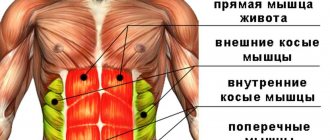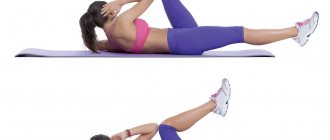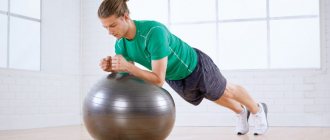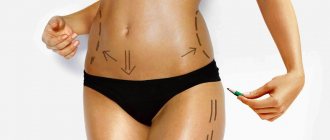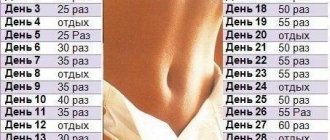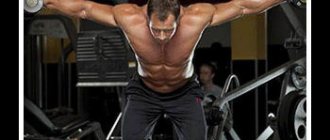Causes of fat deposition in the lower abdomen
There are several main factors influencing the formation of fat in this area:
- genetic predisposition;
- hormonal imbalance (including during pregnancy, taking oral contraceptives);
- poor nutrition;
- passive lifestyle;
- regular stress;
- menopause.
There can be quite a few reasons, and not all of them are related to eating disorders. However, most often the formation of fat occurs precisely because of an incorrect lifestyle. This is especially pronounced in those who regularly eat stress with fatty, high-calorie foods, which provide the brain with huge doses of glucose. In this case, nutritionists recommend reconsidering your habits and, instead of absorbing tasty but harmful foods, escape from stress with physical exercise. For example, with recreational running, the body copes with nervous tension more easily. Such a load is considered one of the best ways to combat insomnia and neurasthenia*.
Why fat accumulates in the lower abdomen
This is primarily due to the characteristics of the human body and centuries of evolution. Once upon a time, fat reserves were necessary for survival in harsh natural conditions. As part of the modern development of society, fat no longer performs such an important function, but our ancient brain continues to accumulate reserves for a rainy day.
This is interesting: women are characterized by the accumulation of subcutaneous fat, while in men it is deposited in the visceral areas. At the same time, estrogens play a huge role in the production of fat deposits: during menopause and after it, when hormonal changes occur in the female body, you can notice an increase in the volume of the waist and hips.*
In addition, modern lifestyle is often associated with sedentary work, unhealthy diet and regular stress. All this contributes to improper distribution of subcutaneous fat and the formation of pronounced deposits in the lower abdomen.
Types of obesity
Before moving on to active measures to combat deposits in the abdominal area, you need to determine what type of obesity the problem belongs to:
- Android type. Fat deposits are especially noticeable in the abdomen and upper torso. This type is typical for men, but women after menopause are also susceptible to its manifestations.
- Gynoid type. Fat accumulates in the thighs and buttocks, causing the figure to take on a pear shape. This is typically “female” obesity.
- Mixed type. Fat deposits are distributed evenly, subcutaneously, which is why the figure takes on the shape of an apple. In this case, the lines of the upper body, waist and hips are visually at the same level.
- Visceral obesity. This type is more typical for men; fat cells are deposited in internal organs, which is fraught with serious health problems.
This is interesting: according to WHO statistics, at least one in three adults in the world is overweight, and one in ten suffers from obesity in one of its stages**.
Medical classification of fat deposits
In medicine, the disease is classified according to different criteria:
- By BMI (body mass index). It is considered an imperfect scheme, since it does not take into account the age and gender of a person, as well as his type of activity***. For example, high BMI in athletes is not explained by excess fat, but by the amount of muscle mass.
- For the reasons and mechanisms of development of the disease.
- According to the clinical pathogenetic picture.
- At the location of fat deposits.
- According to morphological characteristics.
To determine abdominal obesity (accumulation of fatty tissue in the abdomen and upper torso), a coefficient equal to the ratio of waist circumference to hip circumference is used. We can talk about health problems if this coefficient exceeds 0.8 units in women.
Additionally, the disease is classified according to its developmental characteristics: it can be primary obesity (weight increases gradually, deposits are uniform, develops due to poor nutrition) or secondary (occurs against the background of hormonal imbalance).
Ways to fight belly fat
Regardless of the reasons for the appearance of excess volume in the waist area, you can start an independent fight against fat deposits at any time. There are several methods that usually help you get rid of lower belly fat and begin the weight loss process. Of course, if the problem is caused by hormonal imbalances or other disorders of the body, you should consult a specialist before exercising and adjusting your diet. The most common options for getting rid of fat are:
- Nutrition adjustments.
- Physical exercise.
- Normalization of the daily routine.
- Regular eight-hour sleep.
- Protection from stress.
- Rejection of bad habits.
Such radical changes in life will help not only get rid of fat deposits in the abdominal area, but also significantly improve health, improve the condition of skin, hair and nails.
Top exercises for a flat stomach
For a pronounced effect, you need to devote at least three days a week to classes, and then quick results will not keep you waiting. What exercises can you do to work your abdominal muscles and get rid of excess fat in this area?
Raising extended legs.
One of the most effective options for working out the abdominals and thighs, which helps to achieve pronounced results in the shortest possible time. To perform the exercise, lie on the floor with your arms extended along your body. Legs should be straight. Start lifting them up, squeezing them together and tensing your abdominal muscles as much as possible. As a result, your legs should be at an angle of 90 degrees to your body. Hold at the top for a few seconds, then slowly lower back to the starting position. Repeat 15 times, 4 sets. Over time, the number of lifts can be increased, and the legs can not be lowered to the floor, leaving them 10–20 cm above it.
Bike.
A relatively simple exercise that helps get rid of fat in the abdomen, buttocks and thighs. In addition, it perfectly increases endurance. To perform the exercise, lie on your back with your arms extended along your body. Raise your legs so that your hips form a right angle with your body. Bend your knees and begin to straighten them one by one, as if you were pedaling a bicycle. Make sure that your back does not come off the floor and your abs remain tense. Do the exercise for 2-3 minutes until you feel tired.
Twisting.
One of the most effective ways to quickly get rid of fat in the lower abdomen, as well as achieve a thin waist and beautiful muscle definition. To perform the exercise, lie on your back with your knees bent. Place your hands behind your head or cross your chest. Begin to lift your upper body, alternately leaning to the right and left. Repeat 15 times on each side, 4 sets.
It is important! Perform all exercises only after warming up: this will prevent possible injuries and also saturate the blood with oxygen, increasing the effectiveness of the workout.**
A set of exercises for the lower abs
Fat in the lower abdomen is always the last to go. However, there are exercises that will help you overcome it faster.
Crunches
. To perform this, you need to lie on your back, bend your knees, and clasp your hands behind your head. As you inhale, lift your upper body off the floor and pull your elbows up. As you exhale, return to the starting position.
Leg lift.
Lie on your back. Legs straight, lower back pressed to the floor, palms under the buttocks. As you inhale, tighten your abdominal muscles and lift your legs toward the ceiling until you form a right angle with your back. As you exhale, slowly return to the starting position.
Reverse crunches
. Lie on the floor, bend your knees, arms along your body. As you exhale, pull your knees to your chest, and as you inhale, return to the starting position.
It is important! You should not resort to such physical activity if you have problems with the spine, kidneys, cardiovascular system, respiratory system and gastrointestinal diseases.
How else can you exercise if you want to strengthen your abs?
Here are a few more exercises that help get rid of this problem that poisons women’s lives. If you do them for half an hour for a week, the result will be obvious.
Exercise 1.
Place your feet shoulder-width apart. Place your hands over your slightly bent knees. During breathing exercises, pull your stomach in. Move your left leg with your toe extended to the side. Give the straight arm the opposite direction, raising it above your head. Shift your body weight to the other side. We rest our right hand on the bent knee. We strain our left muscles, wait 8-10 seconds, then change sides. Your back should be perfectly straight and your feet should be firmly on the floor. In each direction we repeat the described steps 3-4 times.
Exercise 2.
Lie on the floor and do breathing exercises. Place your arms along your body so that your palms face down. Raise your straight legs slightly above the floor, extending your toes. You need to cross them with each other, alternately bringing them together and apart in the air. You need to perform 3-4 approaches 10 times.
Exercise 3.
You need to lie on your back, bend your knees and place your feet on the floor. Raise your arms straight up. Perform breathing exercises and tighten your stomach. Stretch your arms forward, lifting your shoulders and upper body off the floor as far as possible. Hold your breath and count to eight. Slowly take the starting position. Repeat 5-6 times, trying not to lower your head too low. It is important that you work primarily on your stomach and not your neck. It is also recommended to do lateral raises to engage the obliques.
Exercise 4.
It is also called “Cat”. You need to kneel and lean on your elbows. After breathing exercises, smoothly, using the diaphragm, alternately draw in and inflate the stomach. According to some data, this exercise also has general strengthening and healing effects.
Nutritional adjustments against lower belly fat
According to WHO, physical activity plays a critical role in energy metabolism and maintaining an appropriate weight, and poor diet affects the development of the risk of chronic diseases**. That is why when dealing with excess deposits in the waist area, it is necessary to resort to an integrated approach. Proper nutrition means:
- Refusal of fatty and fried foods, store-bought sweets, large amounts of flour. The diet includes more fiber, fresh vegetables, and protein.
- Giving up bad habits: alcohol is a high-calorie product, the consumption of which directly affects the deposition of fat in the body.
- Maintaining water-salt balance. For normal functioning of the body, you need to drink at least 1.5 liters of clean water daily.
- Adjusting your diet. It is recommended to eat three times a day; between main meals, snacks with nuts, yoghurts, and fruits are allowed.
How to organize meals?
In order to tighten your belly, you first need to pay attention to your diet. Experts recommend temporarily removing the following products from the menu:
- fatty and fried;
- canned food;
- confectionery;
- semi-finished and instant products.
You should be careful when adding sugar and honey to your dishes, as they are high in calories and can interfere with getting rid of extra pounds. You should eat small portions several times a day. The menu must include fruits, vegetables, meat, lean fish, cereals and cereals. It would be nice to do fasting days once a week, but under no circumstances should you go hungry. You should drink at least 1.5-2 liters of water per day so that all organs can function normally.
Making a menu for weight loss
WHO recommends limiting the consumption of “free” sugars and sodium salt, but increasing the amount of fresh fruits and vegetables in the diet. According to experts, this should affect the preservation of health and improve the quality of life, as well as prevent the development of obesity****. Creating your menu in accordance with WHO recommendations is quite simple. We have prepared a table from which you can select suitable products.
| Squirrels | Eggs, dairy products, meat and poultry, fish, seafood |
| Fats | Oils, avocado, nuts, duck, pork |
| Carbohydrates | Whole grain coarse bread, buckwheat, oatmeal, beans, peas, lentils, apples, pears, grapefruits and all vegetables (except pumpkin, potatoes and corn), dark chocolate |
| Beverages | Pure water, green tea, rosehip infusions, high-caffeine drinks without sugar |
Herbalife Nutrition protein shakes can be an additional source of protein. They can replace a full meal and promote a long-lasting feeling of fullness, preventing overeating.
Other ways to quickly lose belly fat
One of the best ways to lose excess weight has been and remains recreational running. When done correctly, it allows you to quickly lose weight and normalize the body’s condition. However, running is contraindicated for people suffering from diseases of the heart and respiratory system, as well as with disorders of the musculoskeletal system. In this case, active jogging can be replaced with walks at an average pace, but for results you can walk for at least thirty minutes a day, gradually increasing the speed. Another way is to purposefully go to a fitness center, where you ask the instructor to select the optimal set of exercises to work all the abdominal muscles. However, before starting classes, you need to know all your contraindications and recommendations. Finally, another way to look more fit is to watch your posture. It not least affects the visual volume of the abdomen.


